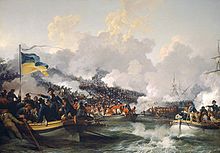|
Battle of Abukir (1801)
The Battle of Abukir of 8 March 1801 was the second pitched battle of the French campaign in Egypt and Syria to be fought at Abu Qir on the Mediterranean coast, near the Nile Delta. The landing of the British expeditionary force under Sir Ralph Abercromby was intended to defeat or drive out an estimated 21,000 remaining troops of Napoleon's ill-fated invasion of Egypt. The fleet commanded by Baron Keith included seven ships of the line, five frigates and a dozen armed corvettes. With the troop transports, it was delayed in the bay for several days by strong gales and heavy seas before disembarkation could proceed.[4] The Landing In the early morning of the 8th March 1801, the landing force consisting of Flank companies of the 40th and the Welsh Fusiliers on the right. In the centre the 28th, 42nd and 58th. On the left, the Brigade of Guards, (formed from a battalion of each regiment) The Corsican Rangers, The Royals and 54th. The landing force totaled 5,230 men. All troops were on board the landing boats by 2 am. Its sailors tightly packed with muskets between their knees, the boats rowed silently to the rendezvous, each were placed in their positions of landing. By 8 am, each brigade was in place. At 9 am, a rocket fired from the Admirals ship signaled the advance and the boats sprang forward. With protection from light armed vessels, ketches and bomb brigs moored broadside to the beach, the troops beached their craft under a rainstorm of French cannonade and musket fire from 2,500 French positioned on the high dunes. The troops disembarked, formed line, fixed bayonets and advanced undaunted by the enemy fire. With General Moore leading at their head they struggled up the steep soft sandy ground. The French appeared at the summit and poured a destructive musket volley. The lead troops of the 42nd reached the summit before the French could reload and launched a bayonet charge, hurling them back in confusion. The French counter attacked with a squadron of cavalry, a second bayonet charge by the 42nd caused them to flee. On the left the Guards were attacked by cavalry and the 54th by Infantry bayonet. Both attacks were brilliantly repulsed. The British were now in control of the shore and advanced to expand the bridgehead. The French deserted their guns. A decisive victory by the British Expeditionary Force. By evening The Navy had landed the remainder of the Army and consolidated control at Aboukir.[5] SummaryThe French garrison of Alexandria under General Friant, some 2,000 French troops and ten field guns in high positions took a heavy toll of a large British force disembarking from a task-force fleet in boats, each carrying 50 men to be landed on the beach. The British then rushed and overwhelmed the defenders with fixed bayonets and secured the position, enabling an orderly landing of the remainder of their 17,500-strong army and its equipment. The skirmish was a prelude to the Battle of Alexandria and resulted in British losses of 730 killed and wounded or missing. The French withdrew, losing at least 300 dead or wounded and eight pieces of cannon.[4] Napoleon later described the British landing as "one of the most vigorous actions which could be imagined".[6] Orders of battleBritish
French
See also
Citations
References
. External links
|
||||||||||||||||||||||||||||||||||||||||||||||||||||||||||||||||||||||||||||||||||||||||||||||||||||||||||||||||||||||||||||||||||||||||||||||||||||

